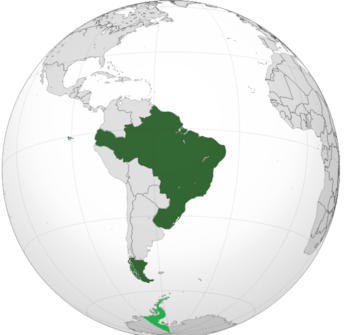Esenia: Difference between revisions
No edit summary |
|||
| Line 89: | Line 89: | ||
==Etymology== | ==Etymology== | ||
==History== | ==History== | ||
The territory which would become known as Esenia is was inhabited by {{wp|Indigenous peoples in Brazil|numerous tribal nations}} prior contact with Europeans. On the eve of the arrival of the {{wp|2nd Portuguese India Armada (Cabral, 1500)|Second Portuguese India Armada in 1500}}, the coastal areas of Esenia had two major tribal groups: the ''{{wp|Tupi people|Tupi}}'' (speakers of {{wp|Tupi–Guarani languages}}), who dominated practically the entire length of the Esenian Atlantic coast, and the ''Tapuia'' (a catch-all term for non-Tupis, mainly {{wp|Jê languages|Jê–Kaingang speakers}}), who resided primarily in the interior. The Portuguese arrived in the dying days of a long and bitter conflict between the Tupis and Tapuias, which resulted in the defeat and expulsion of the Tapuias from most coastal areas. | The territory which would become known as Esenia is was inhabited by {{wp|Indigenous peoples in Brazil|numerous tribal nations}} prior contact with Europeans. On the eve of the arrival of the {{wp|2nd Portuguese India Armada (Cabral, 1500)|Second Portuguese India Armada in 1500}}, the coastal areas of Esenia had two major tribal groups: the ''{{wp|Tupi people|Tupi}}'' (speakers of {{wp|Tupi–Guarani languages}}), who dominated practically the entire length of the Esenian Atlantic coast, and the ''Tapuia'' (a catch-all term for non-Tupis, mainly {{wp|Jê languages|Jê–Kaingang speakers}}), who resided primarily in the interior. The Portuguese arrived in the dying days of a [[Native Coastal War|long and bitter conflict]] between the Tupis and Tapuias, which resulted in the defeat and expulsion of the Tapuias from most coastal areas. | ||
==Geography== | ==Geography== | ||
Revision as of 02:35, 25 September 2023
This article is incomplete because it is pending further input from participants, or it is a work-in-progress by one author. Please comment on this article's talk page to share your input, comments and questions. Note: To contribute to this article, you may need to seek help from the author(s) of this page. |
Empire of Esenia Império de Essênia | |
|---|---|
| Motto: TBA TBA | |
 | |
| Capital | River of January (Rio de Janeiro) Saint Paul (São Paulo) |
| Official languages | English, Portuguese |
| Ethnic groups (2023) |
|
| Demonym(s) | Esenian |
| Government | Federal consitutional monarchy |
| Legislature | TBA |
| Population | |
• 2023 census | 229,546,116 |
| GDP (nominal) | 2023 estimate |
• Total | $9.815 trillion |
• Per capita | $42,759 |
| Gini (2023) | 37.9 medium |
| HDI (2023) | very high |
| Currency | Cruzeiro (C$) |
| Date format | mm-dd-yyyy |
Esenia (Portuguese: Essênia), officially the Empire of Esenia (Portuguese: Império de Essênia), is a country located in South America. It is the only nation on the continent that shares a coastline with both the Atlantic and Pacific Ocean besides Colombia. Esenia is bordered by all other countries in South America and covers roughly half of the continent's land area, making it the largest country in Latin America. It is one of the few nations in the New World with a monarchy. Esenia is the third largest economy in the world as well as the world's seventh most populous country. Due to over a century of mass immigration from around the globe, it is one of the world's most multicultural and ethnically diverse nations, as well as the most populous Roman Catholic-majority country in the world. Esenia's Amazon basin is home to the world's largest and best known tropical rainforest, featuring diverse wildlife, a variety of ecological systems, extensive natural resources, and numerous habitats protected by federal law. This unique environmental heritage makes Esenia a megadiverse country and the most biodiverse country in the world.
Etymology
History
The territory which would become known as Esenia is was inhabited by numerous tribal nations prior contact with Europeans. On the eve of the arrival of the Second Portuguese India Armada in 1500, the coastal areas of Esenia had two major tribal groups: the Tupi (speakers of Tupi–Guarani languages), who dominated practically the entire length of the Esenian Atlantic coast, and the Tapuia (a catch-all term for non-Tupis, mainly Jê–Kaingang speakers), who resided primarily in the interior. The Portuguese arrived in the dying days of a long and bitter conflict between the Tupis and Tapuias, which resulted in the defeat and expulsion of the Tapuias from most coastal areas.

